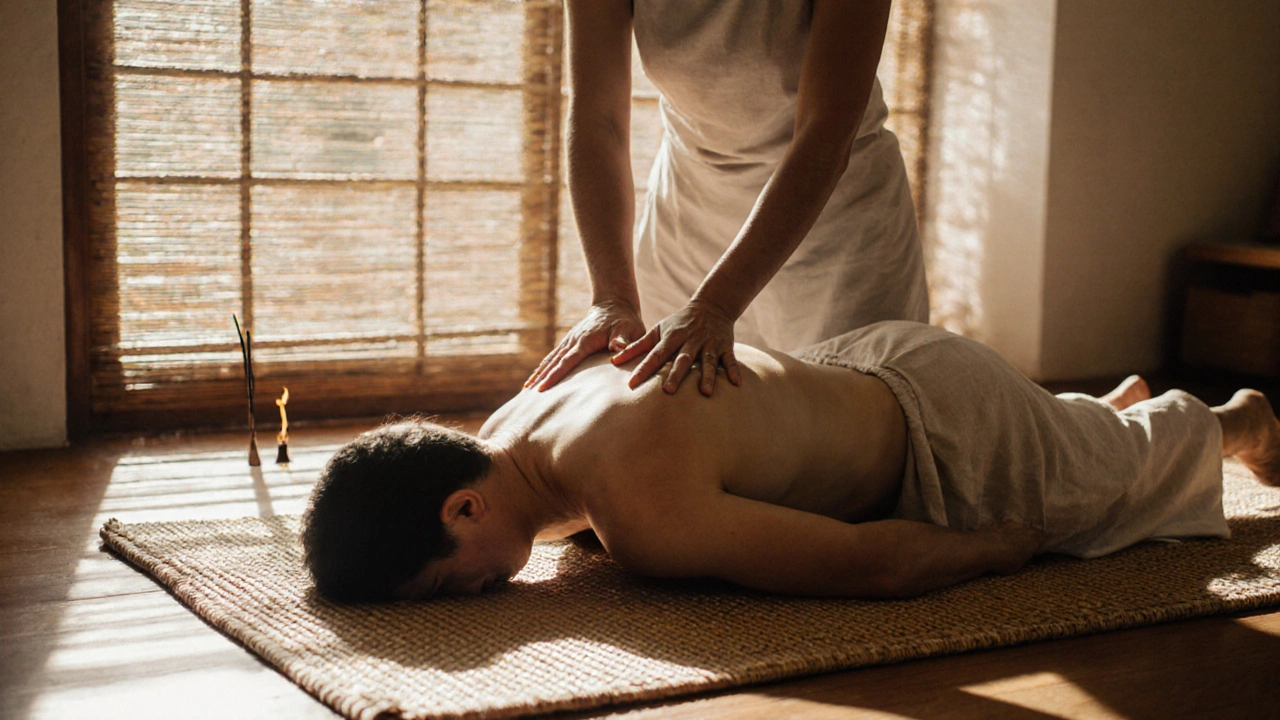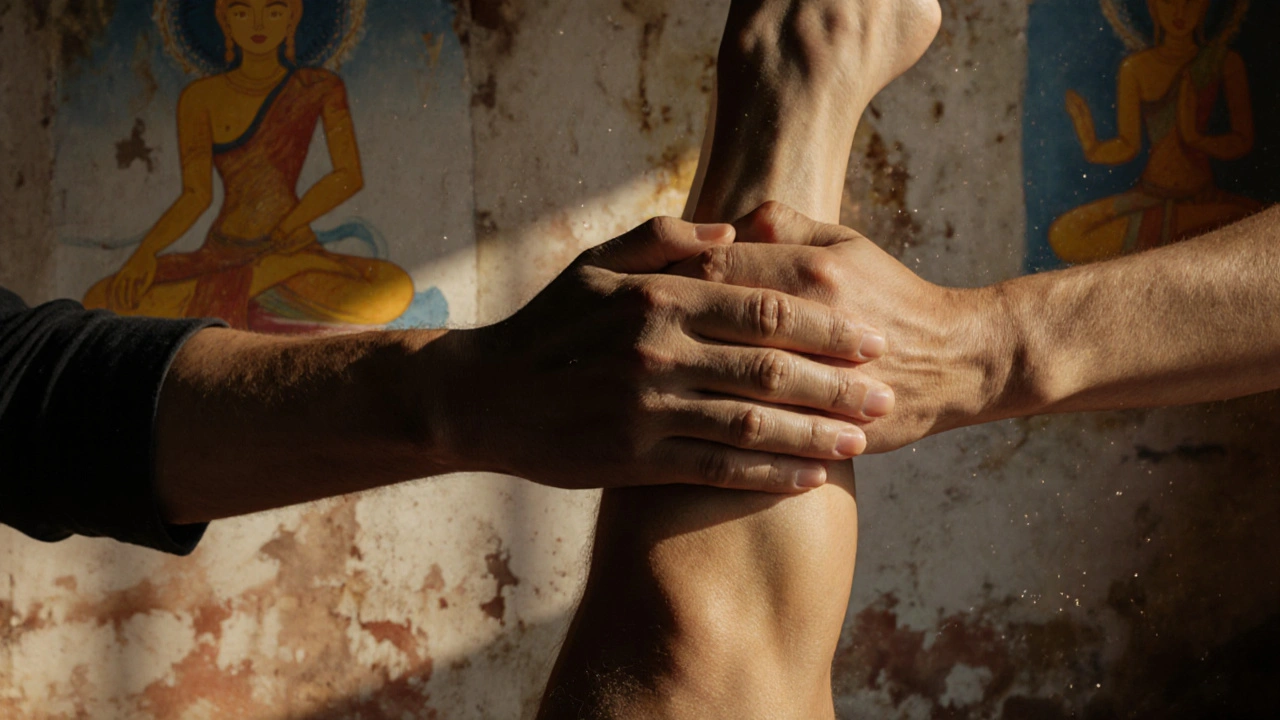Thai Massage: A Pathway to Mind-Body Harmony

Thai massage isn’t just another type of bodywork. It’s a living tradition that’s been passed down for over 2,500 years - not in a lab, not in a spa brochure, but in quiet temples, village homes, and healing schools across Thailand. If you’ve ever tried it, you know it’s not like a Swedish massage. You don’t just lie there. You’re guided through stretches, pressed along invisible lines, and moved like a living puppet - gently, powerfully, with purpose.
What Makes Thai Massage Different?
Most Western massages focus on muscles. Thai massage works on energy lines, called sen lines. There are 72,000 of them in the body, according to traditional belief, but practitioners focus on ten main ones. These aren’t nerves or blood vessels. They’re channels for life energy, or prana, that flow from the heart to the fingertips and toes. Blockages here? That’s where stiffness, fatigue, or even headaches come from.
Unlike oil-based massages, Thai massage is done fully clothed, usually on a mat on the floor. No music, no candles - just your breath, the therapist’s hands, and the quiet rhythm of movement. The therapist uses thumbs, palms, elbows, knees, and even feet to apply pressure and guide you through yoga-like stretches. It’s not passive. You’re part of the process.
How It Feels - Not Just Relaxing, But Realigning
People often say Thai massage hurts. Sometimes it does - but not in a bad way. Think of it like deep stretching after a long day. You feel a burn in your hip as your leg is pulled into a pigeon pose. Your shoulder cracks slightly as your arm is rotated behind you. The pressure builds slowly, then releases. It’s not about pain. It’s about release.
One client from Bristol told me she came in with chronic lower back pain from sitting at a desk all day. After three sessions, she didn’t just feel less pain - she noticed she stood taller. Her shoulders didn’t hunch forward anymore. That’s not magic. That’s the result of opening up the sen lines along her spine and pelvis, letting energy flow again.
It’s not just physical. Many people report feeling calmer, clearer-headed, even emotionally lighter afterward. That’s because Thai massage doesn’t separate body from mind. It assumes they’re the same thing - two sides of one system. When your body moves freely, your thoughts do too.
The Science Behind the Tradition
Modern research is catching up. A 2023 study published in the Journal of Bodywork and Movement Therapies found that people who received Thai massage weekly for six weeks showed measurable improvements in flexibility, reduced cortisol levels (the stress hormone), and better sleep quality. Another trial at Chiang Mai University showed a 40% drop in muscle tension after a single session in participants with desk-job-related stiffness.
The stretches mimic yoga poses - forward bends, twists, leg lifts - but they’re done for you. You don’t have to be flexible. You don’t even have to try. The therapist adjusts every movement to your body’s limits. That’s why it works for athletes, office workers, and seniors alike.
What to Expect in Your First Session
- You’ll wear loose, comfortable clothing - cotton pants and a T-shirt work best.
- No oils, lotions, or scents. You’ll lie on a padded mat on the floor.
- The session lasts 60 to 120 minutes. Most first-timers start with 90 minutes.
- The therapist will ask about injuries, pregnancy, or recent surgeries. Be honest. This isn’t a spa - it’s therapy.
- You’ll be moved, pressed, stretched, and sometimes rocked. It’s not always gentle, but it should never feel violent.
- Afterward, drink water. You might feel a little tired, or oddly energized. Both are normal.

Who Should Try It - And Who Should Skip It
Thai massage is safe for most people. But it’s not for everyone.
Great for:
- People with tight hips, shoulders, or lower back
- Those who sit all day or have poor posture
- Anyone feeling mentally stuck or emotionally drained
- Yoga practitioners looking to deepen their flexibility
Not recommended for:
- Recent fractures or severe osteoporosis
- Acute inflammation or infections
- Deep vein thrombosis (blood clots)
- Severe spinal injuries without clearance from a doctor
If you’re pregnant, it’s still possible - but only with a therapist trained in prenatal Thai massage. The pressure points and stretches change. Don’t assume any therapist can do it safely.
Thai Massage vs. Other Types
| Feature | Thai Massage | Swedish Massage | Deep Tissue | Hot Stone |
|---|---|---|---|---|
| Position | On floor, fully clothed | On table, unclothed (under draping) | On table, unclothed | On table, unclothed |
| Pressure | Variable - firm, rhythmic, stretching | Light to medium, flowing | Deep, focused, slow | Warm, soothing, gliding |
| Focus | Energy lines, flexibility, alignment | Relaxation, circulation | Chronic muscle knots | Relaxation, heat therapy |
| Duration | 60-120 minutes | 60-90 minutes | 60-90 minutes | 60-90 minutes |
| After-effects | May feel stretched, energized, or tired | Relaxed, calm | Sore for 1-2 days | Deeply relaxed, warm |
Where to Find Authentic Thai Massage
Not every place calling itself "Thai massage" is doing it right. Some just mix in a few stretches and call it Thai. True Thai massage comes from a lineage - usually taught in Thailand, often passed down from master to student.
In the UK, look for therapists who:
- Have trained in Thailand - especially at Wat Pho in Bangkok, the birthplace of modern Thai massage
- Use the term "traditional" or "ancient" - not "Thai-inspired"
- Don’t use oils or music - they’re distractions from the core practice
- Ask about your movement history, not just your pain
Ask: "Where did you train?" If they say "online course" or "weekend workshop," walk away. This isn’t a technique you learn in a weekend. It’s a discipline.

How Often Should You Get It?
There’s no rule. But most people find that once a month keeps their body feeling balanced. If you’re dealing with chronic stiffness or stress, once every two weeks for two months can make a real difference. After that, monthly is enough to maintain.
Think of it like brushing your teeth. You don’t wait until your gums bleed. You do it regularly to prevent problems. Thai massage works the same way.
What You Can Do at Home
You don’t need a therapist to feel the benefits of Thai principles. Try this simple routine after work:
- Stand barefoot. Gently roll your shoulders back and down - 5 times.
- Reach one arm overhead, lean gently to the side - hold for 10 seconds. Switch sides.
- Stand on one leg, bend the other knee, and pull your heel toward your glutes. Hold for 15 seconds. Switch legs.
- Seated twist: Sit tall, place your right hand on your left knee, twist gently. Hold 10 seconds. Switch.
- Take five deep breaths, letting your belly expand fully.
Do this for 10 minutes a day. You’ll notice your posture improve. Your breath will deepen. Your mind will quiet.
Why This Isn’t Just Another Massage
Thai massage isn’t about pampering. It’s about restoration. It doesn’t promise to cure your back pain - but it gives your body the space to heal itself. It doesn’t tell you to meditate - but it makes meditation easier by calming your nervous system first.
It’s a bridge between ancient wisdom and modern life. In a world where we’re always doing, always pushing, always connected - Thai massage reminds us how to be still. Not by lying still. But by moving with awareness.
Is Thai massage painful?
It can feel intense, especially if you’re tight or haven’t moved in a while. But it shouldn’t hurt. Good therapists adjust pressure to your comfort. If you feel sharp pain, speak up. The goal is release, not punishment.
Do I need to be flexible to try Thai massage?
No. In fact, most people who try it are the least flexible. The therapist moves you slowly, within your range. You don’t have to stretch - you just have to breathe.
Can Thai massage help with anxiety?
Yes. The rhythmic pressure and stretching activate the parasympathetic nervous system - your body’s "rest and digest" mode. Many people report feeling calmer, less reactive, and more centered after sessions. It’s not a replacement for therapy, but it supports mental well-being.
How long do the effects last?
The immediate relaxation lasts a few hours. The physical benefits - better mobility, less stiffness - can last days to weeks, depending on your lifestyle. Regular sessions (once a month) help maintain the results.
Is Thai massage the same as yoga?
It’s like yoga with a partner. Many poses are similar - but in yoga, you do the work yourself. In Thai massage, someone else moves you into the positions. It’s passive stretching, guided by someone trained in body mechanics.
Next Steps
If you’ve been feeling stiff, sluggish, or mentally foggy - don’t wait for pain to get worse. Try one session. Find a therapist who trained in Thailand. Wear loose clothes. Breathe. Let them move you. You might not understand how it works. But you’ll feel the difference.
It’s not magic. It’s medicine - the kind that’s been around longer than most modern drugs. And it doesn’t come in a pill. It comes in the hands of someone who knows how to listen with their fingers.



